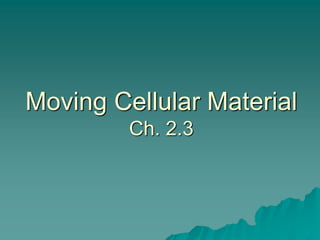
Ch. 2.3 Cell transport
- 1. Moving Cellular Material Ch. 2.3
- 2. Focus Questions 1. How do materials enter & leave cells? 2. What is the difference between passive transport & active transport? 3. Why are osmosis and diffusion important?
- 3. 1. How do materials enter & leave cells? Cell transport No energy/ATP Energy/ATP Passive transport Diffusion Facilitated diffusion Osmosis transport = move Active transport Endocytosis Exocytosis Copy this chart
- 4. Check your vocabulary activity See 2.3 Vocabulary You should already have the definitions that have a dotted underline Add the direction particles move to your vocabulary
- 5. 1. How do materials enter & leave cells? Diffusion: When molecules move from HIGH to LOW concentration ALWAYS: High Low Until both sides reach equilibrium.
- 6. Draw this example of diffusion.
- 7. 1. How do materials enter & leave cells? Osmosis: The diffusion of WATER molecules through a membrane. It always moves from areas with higher concentration of WATER to areas of lower concentration of water. Dilute solution Concentrated solution (high water) (low water)
- 9. 1. How do materials enter & leave cells? Facilitated diffusion: When molecules use transport proteins to pass through a cell’s membrane. 2 types of transport proteins: Carrier proteins – carry large molecules (glucose) Channel proteins – form pores through membrane
- 11. 1. How do materials enter & leave cells? Active Transport: When substances move through the cell membrane using the cell’s energy (ATP). Low High Uses carrier proteins to get nutrients from the environment and to get rid of waste materials.
- 12. Active Transport
- 13. 1. How do materials enter & leave cells? Endocytosis: (endo = enter) takes in a substance by surrounding it (& engulfing) Exocytosis: (exo = exit) Getting rid of contents outside the cell
- 15. 2. What is the difference between passive transport & active transport? Passive transport – does NOT require cell’s energy (no ATP) – depends on differences in concentration of substances – moves from high low Active transport – requires cell’s energy (ATP) –Moves from low high
- 16. 3. Why are osmosis & diffusion important? All living things have certain requirements they must satisfy in order to remain alive & to maintain homeostasis by: – Exchanging gases (O2 & CO2) – Taking in water, minerals, & food – Eliminating wastes
- 17. Remotes Review
- 18. What is the diffusion of water molecules? A. Diffusion B. Endocytosis C. Active transport D. Osmosis E. Exocytosis 0 0 0 0 0 Diffusion Endocytosis Active transport Osmosis Exocytosis 45
- 19. What is the movement of substances from areas of high concentration to low concentration? A. Diffusion B. Endocytosis C. Active transport D. Exocytosis Diffusion 0 0 0 0 Endocytosis Active transport Exocytosis 45
- 20. What is the movement of substances across a membrane that requires cell energy? A. Diffusion B. Osmosis C. Active transport D. Passive transport Diffusion 0 0 0 0 Osmosis Passive transport Active transport 45
- 21. When substances are too large to pass through the membrane, they must enter the cell through what process? A. Osmosis B. Endocytosis C. Exocytosis D. Passive transport Osmosis 0 0 0 0 Endocytosis Exocytosis Passive transport 45
- 22. Which cell part is responsible for making and storing the energy (ATP) needed for active transport? A. Chloroplast B. Nucleus C. Golgi bodies D. Mitochondria E. Lysosome Chloroplast 0 0 0 0 0 Nucleus Golgi bodies Mitochondria Lysosome 45
- 23. Osmosis is the diffusion of water molecules though which of these? 0 0 0 0 A. B. C. D. A. channel proteins B. water C. cell wall D. Cell membrane 45
- 24. What does facilitated diffusion require to pass molecules through a cell membrane? 0% 0% 0% 0% A. B. C. D. A. water B. glucose C. light energy D. transport proteins 45
- 25. During which process do cells take in needed nutrients from the environment through carrier proteins? 0 0 0 0 A. B. C. D. A. endocytosis B. active transport C. exocytosis D. passive transport 45
- 26. How does active transport move substances through the cell membrane? 0 0 0 0 A. B. C. D. A. using the cell’s energy B. by osmosis C. by facilitated diffusion D. using water 45
- 27. Link for animation http://www.northland.cc.mn.u s/biology/biology1111/animati ons/active1.swf